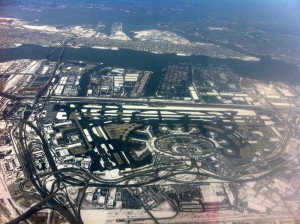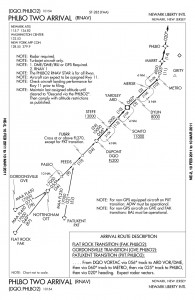 Level at fifteen thousand feet Air Traffic Control (ATC) issued a clearance to descend via the PHLBO TWO arrival into Newark, NJ (EWR). We were 30 miles southwest of DQO which has a crossing restriction at or above twenty thousand feet. We are already at fifteen thousand, which is below the crossing restriction of twenty thousand, so when can we begin our descent?
Level at fifteen thousand feet Air Traffic Control (ATC) issued a clearance to descend via the PHLBO TWO arrival into Newark, NJ (EWR). We were 30 miles southwest of DQO which has a crossing restriction at or above twenty thousand feet. We are already at fifteen thousand, which is below the crossing restriction of twenty thousand, so when can we begin our descent?
If your answer was to begin your descent to cross STEFE at or above thirteen thousand you would be correct. But can we begin our descent prior to DQO? Yes. To understand why let us review arrivals with crossing restrictions and what ATC expects when they issue a clearance to "descend via".
A descend via clearance instructs you to follow any altitude restrictions published on the standard terminal arrival (STAR). You must also comply with any other restrictions including airspeeds if charted.
If ATC assigns you an altitude after issuing a descend via clearance the descend via clearance is cancelled and you must maintain the assigned altitude. You may also be assigned a modified "descend via" clearance in which case you must comply with the modification and then comply with the remainder of the published restrictions.
Flying at seventeen thousand feet, 20 miles southwest of DQO you are given the clearance to descend via the PHLBO TWO. You must begin your descent to cross STEFE at or above thirteen thousand as depicted and to further cross SOMTO at eleven thousand.
Since you where previously assigned seventeen thousand, ATC has already modified the arrival and you do not have to comply with the twenty thousand foot restriction at DQO. This can be confusing at first glance but remember ATC can modify any arrival by issuing a clearance.
Example:
Arriving on the PHLBO TWO ATC issues the clearance to descend via the PHLBO TWO except cross DQO at seventeen thousand. Since ATC has modified the arrival, you should plan your descent to cross DQO at seventeen thousand instead of twenty thousand and then comply with the remainder of the restrictions.
Example:
Arriving on the PHLBO TWO you receive the clearance to cross DQO at ten thousand and then descend via the PHLBO TWO. ATC has modified the arrival so you don't need to cross SOMTO at eleven because you have already crossed DQO at ten thousand. Using common sense, if you were given a clearance to descend and the restriction of eleven thousand is above your current altitude you would obviously not climb if you are descending via the STAR.
Conclusion:
When ATC issues you a clearance to descend via a STAR you are required to comply with any published restrictions and any modifications issued by ATC. If you are already below a published crossing altitude and the clearance has been modified you do not have to comply with the higher restriction and you may begin your descent to comply with any further altitude restrictions on the arrival. Simply remember to comply with the published or assigned altitudes and you will remain in compliance with the arrival.
Safe Flying.


Comments on this entry are closed.